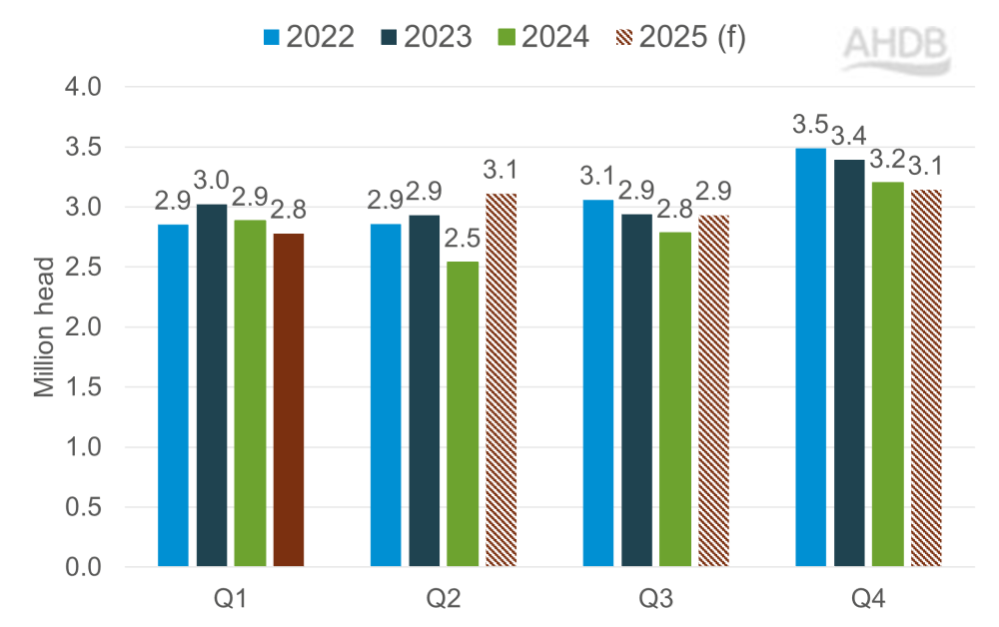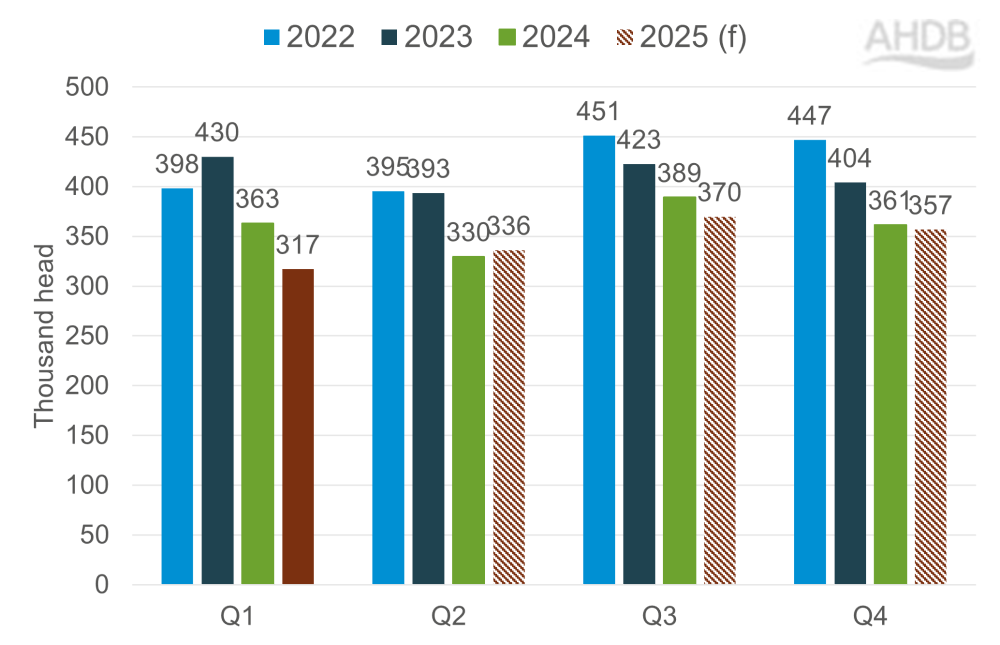Lamb outlook production update: Revised forecast points to higher production in 2025
Friday, 16 May 2025
Key points
- Total sheep meat production for 2025 is expected to total 276,000 tonnes, up 4% on the year, driven by a larger carryover of lambs from 2024.
- The female breeding flock at December 2024 fell by 5% year on year, to sit at 13.1 million head.
- The lamb crop for the 2025/26 season is estimated to be 15.6 million head, down 1% on the previous season, with a contraction in the breeding flock outweighing an expected improvement in rearing rate.
What has changed since the last forecast?
- The breeding flock at December 2024 was smaller than forecast, reducing the number of ewes available to breed the 2025/26 lamb crop.
- Total sheep meat production in 2025 has been revised upwards to 276,000 tonnes driven by a higher carryover of lambs from last year’s crop.
- Clean sheep slaughter numbers in Q1 were lower than forecast, pushing a higher old season lamb (OSL) kill into the Q2 forecast total.
- The 2025/26 lamb crop is expected to be marginally bigger than initially forecast, following reports of better weather and reduced disease instance at lambing, contributing to an improvement in average rearing rates.
2025 forecast
Breeding flock numbers
The breeding flock consists of ewes intended for further breeding and slaughter, and ewes intended for first time breeding (ewe lambs). The Defra UK December breeding flock figure was lower than our forecast, to sit at 13.1 million head. This has further reduced the number of animals available to breed the 2025/26 lamb crop.
Lamb crop
Despite this reduction in the breeding flock, the 2025 lamb crop forecast has been revised slightly upwards to 15.6 million head. This is still 1% smaller than last season’s crop. The reduction in the breeding flock is partially counteracted by an assumed improvement in average rearing rates. This is due to the favourable weather we have seen this lambing season compared to the conditions last year. Reports have also suggested a much lower disease instance so far in 2025, improving lamb survivability.
Clean sheep slaughter
Defra’s clean sheep slaughter in Q1 (Jan-Mar) of 2025 has been lower than initially forecast, totalling 2.8 million head. This is despite the most recent population data showing a greater proportion of the 2024 lamb crop still alive at December, indicating a significant proportion of animals available to be carried over into the new year’s kill. Liveweight data from the LAA showed a much lower proportion of new season lambs (NSLs) in Q1 kill of 2025 than in previous years, further supporting reports of high carryover making up the vast majority of kill in the early part of this year.
We forecast that this higher carryover will continue to support kill in Q2, with clean sheep slaughter forecast at 3.1 million head for Apr-Jun, with OSLs making up a higher proportion of this total than in previous years.
In the second half of 2025, we expect clean sheep slaughter to sit much closer to year ago levels, with Q3 and Q4 totalling 2.9 and 3.1 million head, respectively.
Actual and forecast UK clean sheep slaughter

Source: Defra, LAA, AHDB forecasts in hashed bars
© Livestock Auctioneers Association Limited 2025. All rights reserved.
Carcase weights
So far this year (Q1) we have seen year-on-year increases in average clean sheep carcase weights, from 20.4kg in 2024 to 20.6 kg in 2025. This highlights the higher proportion of older, heavy lambs going through abattoirs.
Adult sheep slaughter
Adult sheep slaughter was below forecast in Q1. However, this is concurrent with the reduced breeding flock and lower ewe replacement rates in the wake of an exceptional lamb trade last year. We have also seen reports of a later lambing, which would in turn slow cull ewes to the market.
We expect adult sheep slaughter for the full year to total 1.4 million head, down 4% year-on-year. This reduction is primarily driven by the smaller breeding flock, with fewer adult females available to slaughter.
Actual and forecast UK adult sheep slaughter

Source: Defra, AHDB forecasts in hashed bars
Production
Sheep meat production estimates have been revised upwards to 276,000 tonnes, a 1% increase from our last forecast and a 4% increase year-on-year. However, this is a 4% decrease from 2023 levels.
This increase is expected to be driven by the heavier carcase weights and higher clean sheep slaughterings in the second quarter of 2025, as the remainder of the 2024 lamb crop comes forward and 2025 NSLs are marketed. Indeed, we have already seen year-on-year increases in clean sheep slaughter for April, and we expect slaughter levels to remain elevated from last year for the coming months.
Conclusion
In summation, whilst the current favourable weather from this year’s lambing may indicate a return to normality in terms of production looking forward – we are still very much still feeling the effects of the 2024 season. As such, greater supplies, compared to last year, are likely to continue to weigh on price growth at the farmgate as we have seen so far this season, with prices moving largely sideways through 2025.

Sign up for regular updates
You can subscribe to receive Beef and Lamb market news straight to your inbox. Simply fill in your contact details on our online form.
While AHDB seeks to ensure that the information contained on this webpage is accurate at the time of publication, no warranty is given in respect of the information and data provided. You are responsible for how you use the information. To the maximum extent permitted by law, AHDB accepts no liability for loss, damage or injury howsoever caused or suffered (including that caused by negligence) directly or indirectly in relation to the information or data provided in this publication.
All intellectual property rights in the information and data on this webpage belong to or are licensed by AHDB. You are authorised to use such information for your internal business purposes only and you must not provide this information to any other third parties, including further publication of the information, or for commercial gain in any way whatsoever without the prior written permission of AHDB for each third party disclosure, publication or commercial arrangement. For more information, please see our Terms of Use and Privacy Notice or contact the Director of Corporate Affairs at info@ahdb.org.uk © Agriculture and Horticulture Development Board. All rights reserved.

